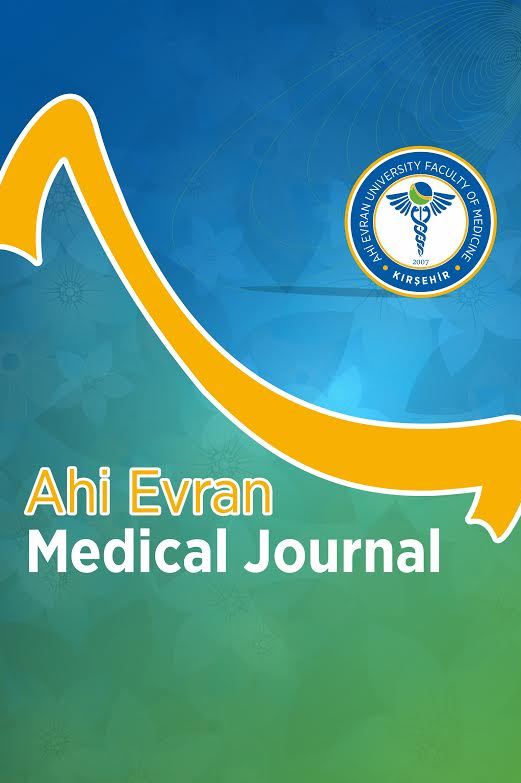Hemorajik İnmeli Hastalarda Homosistein Düzeyleri
hemorajik inme, homosistein, folik asit, B12 vitamini
Homocysteine Levels in Patients with Hemorrhagic Stroke
hemorragic stroke, homocysteine, vitamin B12, folic acid,
___
- 1. Azad MAK, Huang P, Liu G, ve ark. Hyperhomocysteinemia and cardiovascular disease in animal model. Amino Acids. 2018;50(1):3-9.
- 2. Holmen M, Hvas AM, Arendt JFH. Hyperhomocysteinemia and Ischemic Stroke: A Potential Dose-Response Association-A Systematic Review and Meta-analysis. TH Open. 2021;5(3):e420-e437.
- 3. Holmes MV, Newcombe P, Hubacek JA, ve ark. Effect modification by population dietary folate on the association between MTHFR genotype, homocysteine, and stroke risk: a meta-analysis of genetic studies and randomised trials. Lancet. 2011;378(9791):584-594.
- 4. Lehotský J, Tothová B, Kovalská M, ve ark. Role of Homocysteine in the Ischemic Stroke and Development of Ischemic Tolerance. Front Neurosci. 2016;10:538.
- 5. Li Q, Zhao Z, Si K, ve ark. Correlation between the levels of NLRP3, Hcy, IL-1β, IL-18 and the prognosis in patients with hemorrhagic stroke. Am J Transl Res. 2021;13(4):2883-2890.
- 6. Zeng C, Lin F, Ge P, Zhang D, Wang S, Zhao J. Homocysteine Level and Risk of Hemorrhage in Brain Arteriovenous Malformations. Dis Markers. 2021;2021:8862299.
- 7. Zhou Z, Liang Y, Qu H, ve ark. Plasma homocysteine concentrations and risk of intracerebral hemorrhage: a systematic review and meta-analysis. Sci Rep. 2018;8(1):2568.
- 8. Frontera JA, Starling R, Cho SM, ve ark. Risk factors, mortality, and timing of ischemic and hemorrhagic stroke with left ventricular assist devices. J Heart Lung Transplant. 2017;36(6):673-683.
- 9. Chen G, Ping L, Zhou S, ve ark. Early prediction of death in acute hypertensive intracerebral hemorrhage. Exp Ther Med. 2016;11(1):83-88.
- 10. Al-Khaled M, Eggers J. Prognosis of intracerebral hemorrhage after conservative treatment. J Stroke Cerebrovasc Dis. 2014;23(2):230-234.
- 11. Iso H, Moriyama Y, Sato S, ve ark. Serum total homocysteine concentrations and risk of stroke and its subtypes in Japanese. Circulation. 2004;109(22):2766-2772.
- 12. Zhou F, Chen B, Chen C, ve ark. Elevated homocysteine levels contribute to larger hematoma volume in patients with intracerebral hemorrhage. J Stroke Cerebrovasc Dis. 2015;24(4):784-788.
- 13. Yao ES, Tang Y, Xie MJ, Wang MH, Wang H, Luo X. Elevated Homocysteine Level Related to Poor Outcome After Thrombolysis in Acute Ischemic Stroke. Med Sci Monit. 2016;22:3268-3273.
- 14. Karakurum Goksel B, Karatas M, Nebioglu A, ve ark. Subclinical hypothyroidism, hyperhomocysteinemia and dyslipidemia: investigating links with ischemic stroke in Turkish patients. Neurol Res. 2007;29(8):871-876.
- 15. Celikbilek A, Goksel BK, Zararsiz G, Benli S. Spontaneous intra-cerebral hemorrhage: A retrospective study of risk factors and outcome in a Turkish population. J Neurosci Rural Pract. 2013;4(3):271-277.
- 16. Ahmadinejad N, Movahedinia S, Movahedinia S, Shahriari M. Association of mammographic density with pathologic findings. Iran Red Crescent Med J. 2013;15(12):e16698.
- 17. Jeon SB, Kang DW, Kim JS, Kwon SU. Homocysteine, small-vessel disease, and atherosclerosis: an MRI study of 825 stroke patients. Neurology. 2014;83(8):695-701.
- 18. Kalra DK. Homocysteine and cardiovascular disease. Curr Atheroscler Rep. 2004;6(2):101-106.
- 19. Moretti R, Giuffré M, Caruso P, Gazzin S, Tiribelli C. Homocysteine in Neurology: A Possible Contributing Factor to Small Vessel Disease. Int J Mol Sci. 2021;22(4):2051.
- 20. Wald DS, Law M, Morris JK. Homocysteine and cardiovascular disease: evidence on causality from a meta-analysis. Bmj. 2002;325(7374):1202.
- 21. Yang G, Shao G. Clinical effect of minimally invasive intracranial hematoma in treating hypertensive cerebral hemorrhage. Pak J Med Sci. 2016;32(3):677-681.
- 22. Chen S, Dong Z, Cheng M, ve ark. Homocysteine exaggerates microglia activation and neuroinflammation through microglia localized STAT3 overactivation following ischemic stroke. J Neuroinflammation. 2017;14(1):1-12.
- 23. Wiernicki I, Millo B, Safranow K, Gorecka-Szyld B, Gutowski P. MMP-9, homocysteine and CRP circulating levels are associated with intraluminal thrombus thickness of abdominal aortic aneurysms: new implication of the old biomarkers. Dis Markers. 2011;31(2):67-74.
- 24. Min H, Hong J, Cho IH, ve ark. TLR2-induced astrocyte MMP9 activation compromises the blood brain barrier and exacerbates intracerebral hemorrhage in animal models. Mol Brain. 2015;8(1):1-14.
- 25. Dhandapani S, Goudihalli S, Mukherjee KK, ve ark. Prospective study of the correlation between admission plasma homocysteine levels and neurological outcome following subarachnoid hemorrhage: a case for the reverse epidemiology paradox? Acta Neurochir (Wien). 2015;157(3):399-407.
- 26. Suo Y, Chen W, Pan Y, ve ark. Magnetic Resonance Imaging Markers of Cerebral Small Vessel Disease in Hematoma Expansion of Intracerebral Hemorrhage. J Stroke Cerebrovasc Dis. 2018;27(7):2006-2013.
- 27. Sato S, Uehara T, Hayakawa M, Nagatsuka K, Minematsu K, Toyoda K. Intra- and extracranial atherosclerotic disease in acute spontaneous intracerebral hemorrhage. J Neurol Sci. 2013;332(1-2):116-120.
- 28. Al-Delaimy WK, Rexrode KM, Hu FB, ve ark. Folate intake and risk of stroke among women. Stroke. 2004;35(6):1259-1263.
- Yayın Aralığı: Yılda 3 Sayı
- Başlangıç: 2017
- Yayıncı: Kırşehir Ahi Evran Üniversitesi
Beyin Ölümü Tanısı Almış Hastaların Optik Sinir Kılıf Çaplarının Retrospektif Olarak İncelenmesi
COVID-19 Hastalarında Antioksidanların ve Oksidatif Hasarın Durumu
İrfan BİNİCİ, Hamit Hakan ALP, Zübeyir HUYUT, Esra GÜRBÜZ, Hülya GÜNBATAR, Şükrü AKMEŞE, Mustafa Kasım KARAHOCAGİL, Halil İbrahim AKBAY
Sigara İçenlerde Serum Scube-1 Düzeyleri ve Etkileyen Faktörlerin Değerlendirilmesi
Sibel TUNÇ KARAMAN, Okcan BASAT
Cemal ÇİÇEK, Altan AKINEDEN, Selçuk TÜRKEL
Vaka ve Ölüm Sayılarının Kısa Dönem Tahmini için Resmi Kaynaklardan COVID-19 Veri Takibinin Önemi
Hemorajik İnmeli Hastalarda Homosistein Düzeyleri
Aysu YETİŞ, Asuman ÇELİKBİLEK, Aysel KAYA TEKEŞİN, Orhan YAĞIZ
Kemiksiz Çekiç Parmağın Splintleme ve Perkütan Pinleme Tedavileri: Retrospektif Klinik Çalışma
